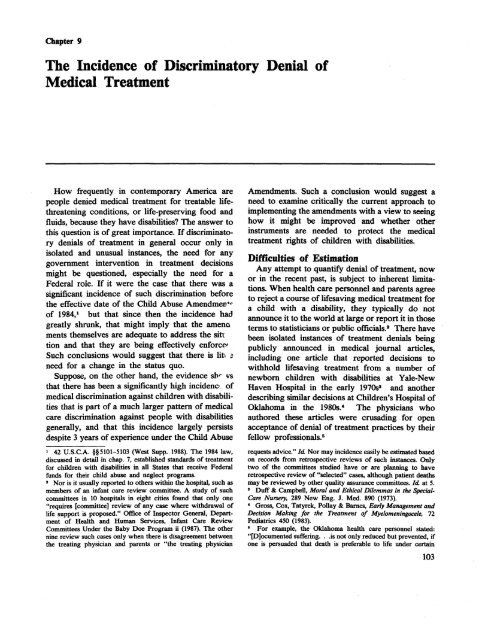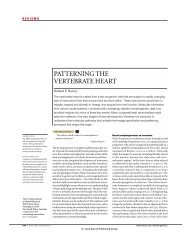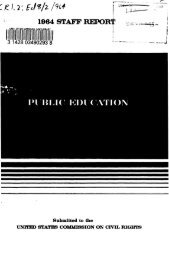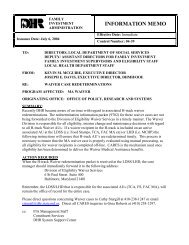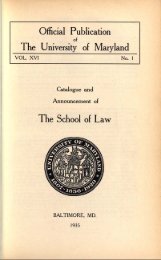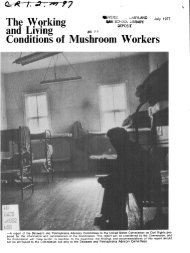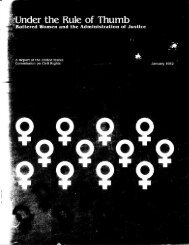PDF1 - University of Maryland School of Law
PDF1 - University of Maryland School of Law
PDF1 - University of Maryland School of Law
Create successful ePaper yourself
Turn your PDF publications into a flip-book with our unique Google optimized e-Paper software.
Chapter 9The Incidence <strong>of</strong> Discriminatory Denial <strong>of</strong>Medical TreatmentHow frequently in contemporary America arepeople denied medical treatment for treatable lifethreateningconditions, or life-preserving food andfluids, because they have disabilities? The answer tothis question is <strong>of</strong> great importance. If discriminatorydenials <strong>of</strong> treatment in general occur only inisolated and unusual instances, the need for anygovernment intervention in treatment decisionsmight be questioned, especially the need for aFederal role. If it were the case that there was asignificant incidence <strong>of</strong> such discrimination beforethe effective date <strong>of</strong> the Child Abuse Amendmeu*'-<strong>of</strong> 1984, 1 but that since then the incidence hadgreatly shrunk, that might imply that the amenoments themselves are adequate to address the sitition and that they are being effectively enforce'Such conclusions would suggest that there is lit sneed for a change in the status quo.Suppose, on the other hand, the evidence sb'" vsthat there has been a significantly high incidenc <strong>of</strong>medical discrimination against children with disabilitiesthat is part <strong>of</strong> a much larger pattern <strong>of</strong> medicalcare discrimination against people with disabilitiesgenerally, and that this incidence largely persistsdespite 3 years <strong>of</strong> experience under the Child Abuse142 U.S.C.A. §§5101-5103 (West Supp. 1988). The 1984 law,discussed in detail in chap. 7, established standards <strong>of</strong> treatmentfor children with disabilities in all States that receive Federalfunds for their child abuse and neglect programs.3Nor is it usually reported to others within the hospital, such asmembers <strong>of</strong> an infant care review committee. A study <strong>of</strong> suchcommittees in 10 hospitals in eight cities found that only one"requires [committee] review <strong>of</strong> any case where withdrawal <strong>of</strong>life support is proposed." Office <strong>of</strong> Inspector General, Department<strong>of</strong> Health and Human Services, Infant Care ReviewCommittees Under the Baby Doe Program ii (1987). The othernine review such cases only when there is disagreement betweenthe treating physician and parents or "the treating physicianAmendments. Such a conclusion would suggest aneed to examine critically the current approach toimplementing the amendments with a view to seeinghow it might be improved and whether otherinstruments are needed to protect the medicaltreatment rights <strong>of</strong> children with disabilities.Difficulties <strong>of</strong> EstimationAny attempt to quantify denial <strong>of</strong> treatment, nowor in the recent past, is subject to inherent limitations.When health care personnel and parents agreeto reject a course <strong>of</strong> lifesaving medical treatment fora child with a disability, they typically do notannounce it to the world at large or report it in thoseterms to statisticians or public <strong>of</strong>ficials. 2 There havebeen isolated instances <strong>of</strong> treatment denials beingpublicly announced in medical journal articles,including one article that reported decisions towithhold lifesaving treatment from a number <strong>of</strong>newborn children with disabilities at Yale-NewHaven Hospital in the early 1970s 3 and anotherdescribing similar decisions at Children's Hospital <strong>of</strong>Oklahoma in the 1980s. 4 The physicians whoauthored these articles were crusading for openacceptance <strong>of</strong> denial <strong>of</strong> treatment practices by theirfellow pr<strong>of</strong>essionals. 5requests advice." Id. Nor may incidence easily be estimated basedon records from retrospective reviews <strong>of</strong> such instances. Onlytwo <strong>of</strong> the committees studied have or are planning to haveretrospective review <strong>of</strong> "selected" cases, although patient deathsmay be reviewed by other quality assurance committees. Id. at 5.3Duff & Campbell, Moral and Ethical Dilemmas in the Special-Care Nursery, 289 New Eng. J. Med. 890 (1973).4Gross, Cox, Tatyrek, Pollay & Barnes, Early Management andDecision Making for the Treatment <strong>of</strong> Myelomeningocele, 72Pediatrics 450 (1983).5For example, the Oklahoma health care personnel stated:"[D]ocumented suffering. . .is not only reduced but prevented, ifone is persuaded that death is preferable to life under certain103


